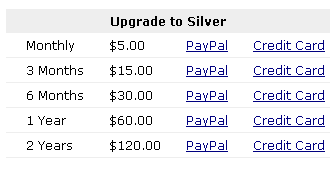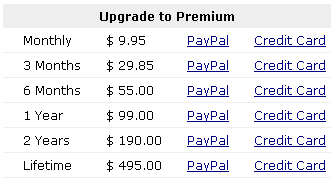Someone asked me what order I’m sharing my revenue streams. Each Friday I’ve looked at the list of ten and thought, “I want to blog about this one today!” There are a few that I’m not ready to blog about, so those are out for now, and others, like this one, that are quite easy.
Today let’s talk about the most obvious one… the revenue stream everyone could have guessed: getting people who use JibberJobber to upgrade. Here are some thoughts on this:
This is a passive revenue stream, and I like that.
If I needed to, I could walk away right now and there would still be old revenue coming in, and new revenue coming in. JibberJobber.com, the product, is established to the point where I don’t NEED to keep working on it. However, we put a significant amount of money into it because we feel there is a ton of room for improvement… but my point is, the income is passive. Lesson? Passive is awesome. Just realize that getting to the point where the money continues to come in, passively, takes a lot of work!
Managing this revenue stream takes resources.
I mentioned that I could walk away from this if needed (for example, let’s say I go get a job somewhere… that won’t affect JibberJobber, or the upgrades (=income)). But I am still paying for a server, and my team who is doing development (programming), business analysis (reviewing competitors, best-in-class CRM tools, and suggestions from users), quality assurance (I’d rather we test the new development than our users ;)), etc. I’m sure there are other ways to create a passive income stream that have no overhead, but this is what I’ve chosen. Lesson? If you think you are going to create a passive income stream, think about what overhead it will require to keep up and running, producing, and competitive.
This revenue stream is Business to Consumer (B2C), which is QUITE different than Business to Business (B2B).
This is my first role where I’m directly responsible for B2C, and wow it’s different than what I’m used to. I watched sites like MySpace and Facebook grow like weeds and was sure that within a few months I’d be buying all new servers, and a few months later I’d be rolling in the dough from all of the upgrade money. What I learned was that getting just one more signup was a challenge… just because you build it they won’t come… there’s a lot more to getting that next signup than just having a cool product. Lesson? Product is one thing, but you better understand you are going to have to market it, creatively and effectively, to create revenue.
Getting “conversions” is equally as difficult as getting signups.
Convincing someone to become proactive about their network management is like getting someone to balance their checkbook… it’s not glamorous or fun, and the immediate benefits are not apparent. There are benefits, but how many of YOU are doing it right/well? See my point? Of the total number of people who signup, I’ll only get a percentage of those who actually USE JibberJobber, and a smaller percentage who PAY to use the upgraded level. I heard that a freemium model like this (freemium -> free with an optional upgrade to premium) is successful if you get 1/2 of one percent (that is: .5%) of total signups to upgrade. That is, if I have 10,000 signups, I’m supposedly successful if I get 50 people to upgrade. Isn’t that crazy?
Fortunately I’m beyond that, as more than .5% of my users have seen enough value in the upgrade. Lesson? If though you set up something uber-cool, and everyone and their mom will need it, don’t call that realtor in the Carribean just yet… execute on your business plan and get those conversions before you spend all of the (anticipated) revenue. BONUS Lesson? Getting conversions was a “hurry up and wait” proposition, leaving time to work on other revenue streams, building the brand, marketing, etc. But it builds over time, which is pretty cool.
JibberJobber, signups, users and upgrades is my core business. Not ad revenue.
Notice I don’t have any ads in JibberJobber? We have Partner’s announcements and offerings, but no Google ads, banner ads, etc. I know people can make tons of money with those, but we don’t for three main reasons:
- JibberJobber already has a very busy interface… for a few hundred dollars a day or a month, it’s simply not worth it to me to add irrelevant clutter (especially with Google Ads, which has too many stipulations that are not user-friendly for my users).
- We got kicked out of Google ads for life… early on, back in 2006, I had ads in some places, but someone from Mexico clicked on my ads 1,000 times in one day. I emailed Google to ask what I should do about it and a few days later they kicked me out of their ad program, took ALL the money away (they owed me money but credited it ALL back to their advertisers, even before that day of click fraud). There is no recourse for this, and I’m banned from life. Nice policy Google. Dorks. But in the end this was good because… (see #3)
- I was getting sidetracked with advertising opportunities… I read a book on how to optimize Google ads, which took time away from core development. I was having my dev team play with the ad placement, which was a distraction from our product. When I got kicked out I realized I should have spent more time on my core, not on distraction worth pennies and costing a lot in missed opportunities.
Lesson? When you start a revenue stream you’ll see shiny objects that seem cool. Think about whether that helps you reach your revenue goals. Google ads seemed to fit the bill, but they were simply a distraction.
Different upgrades make sense to different people.
I started with two levels – free and premium. Based on feedback we added a mid-level, called Silver. And we give various upgrade time frames, with price breaks based on how much you purchase. And various ways to upgrade (PayPal vs. credit card). Like this:
Lesson? Cater. Some want PayPal, some hate PayPal. Some want monthly, some want Lifetime. Some want $10, some want $5. Think about creating your pricing model to cater WITHOUT confusing. To many customizations would make it too hard for some people to actually buy your stuff.
I realize developing a site like JibberJobber is something most of you won’t do, but many of you have asked me about subscription models. I hope this dialogue helps you think this idea through.
If you have a subscription model, or have participated in one, what do you think makes it successful?
Here is a breakdown of the revenue streams I’ve shared so far:
- Revenue Stream 1: JibberJobber User Upgrades
- Revenue Stream 2: JibberJobber Partnership Program
- Revenue Stream 3: Books I write
- Revenue Stream 4: (not announced yet)
- Revenue Stream 5: Professional Speaking
- Revenue Stream 6: Consulting
- Revenue Stream 7: (not announced yet)
- Revenue Stream 8: (not announced yet)
- Revenue Stream 9: (not announced yet)
- Revenue Stream 10: (not announced yet)



Jason, this is for you https://www.internetinc.com/authenticity
By the way, we were banned for life from AdSense for an equally silly situation maybe in 2004 or 2005 but were reinstated after meeting and pestering enough Google employees…
In your situation, I think you are better off without the ads. AdSense effectiveness has gone way down in the past 3 to 5 months.
-eric
Lesson? Product is one thing, but you better understand you are going to have to market it, creatively and effectively, to create revenue.
Jason:
This is a great point. In the non-profit world, many organizations have a mission or cause for which its staff are very passionate and assume others will be as well. Then the management of the organization becomes can not understand why they they struggle to get folks to take advantage of their services or, very importantly, donate money to support the organization. Then, you look at the organization and they are making no real effort to market themselves. In fact, many consider marketing” beneath them.” Very few organizations can exist and prosper using the build it and they will come approach.